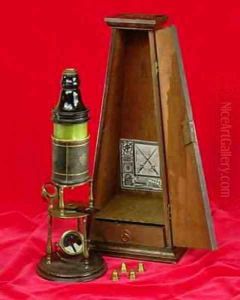Edmund Culpeper Paintings
Edmund Culpeper was an English engineer, instrument maker, and a notable figure in the history of the development of the microscope. Born in 1660, Culpeper's work in the early 18th century played a significant role in popularizing the use of microscopes for scientific exploration, making substantial contributions to the fields of biology and microscopy. Though not primarily known as an artist in the traditional sense, his craftsmanship and innovations in designing and improving microscopes have left a lasting legacy in the visual and scientific examination of the natural world.
Culpeper's microscopes were renowned for their superior quality and usability. He introduced several improvements to the compound microscope, which at the time was a relatively new invention struggling with issues of clarity and ease of use. Among his innovations was the tripod design, providing a more stable and user-friendly platform for scientific observation. Culpeper's microscopes also featured an ingenious system of screws for focusing, which greatly improved the precision with which observers could examine specimens. This focus on functionality, combined with the aesthetic appeal of his brass and silver designs, made Culpeper's microscopes highly sought after by scientists and affluent hobbyists alike.
Despite his contributions to the field of microscopy, detailed records of Culpeper's life and career are somewhat limited, and much of what is known comes from the legacy of his instruments. He worked in London, where he established himself as a leading instrument maker, and his work was widely recognized and respected by his contemporaries. Culpeper's microscopes facilitated many scientific discoveries of the 18th century, and his designs influenced the development of optical instruments well beyond his lifetime. After his death in 1738, Culpeper's innovations continued to inspire instrument makers and scientists, securing his place in the history of science and technology. His work exemplifies the intersection of artistry, craftsmanship, and scientific inquiry, highlighting the profound impact that thoughtful design and innovation can have on the advancement of knowledge.
